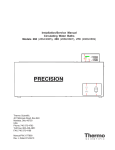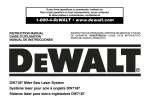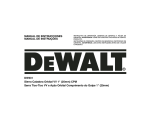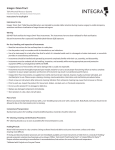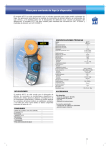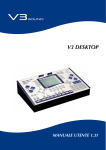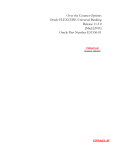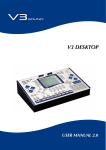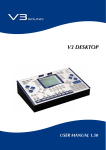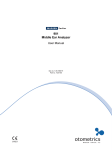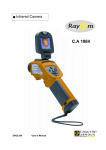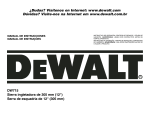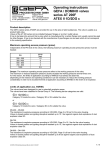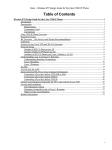Download Installation/Service Manual Thelco Incubator
Transcript
Installation/Service Manual Thelco Incubator Models 2DG (3501), 3DG (3503), 5DG (3505), 6DG (3507), 3DM (3509), 5DM (3511), 6DM (3513) Hig h Low On He ate r On laboratory Re cord er Outp ut O ff INCUBATOR Thermo Electron Corporation Millcreek Road, Box 649 Marietta, Ohio 45750 USA Phone: 740-373-4763 Toll Free: 800-848-3080 FAX: 740-373-4189 Manual P/N 3179179 Rev. E Dated 13APR06 ENTER Tem p . Hig h Limit Mute NOTE: THE UNITS DESCRIBED IN THIS MANUAL WERE DESIGNED SPECIFICALLY FOR THE EUROPEAN MARKET AND ARE SUPPLIED WITH A EUROPEAN STYLE POWER CORD. FOR DOMESTIC USE, A U.S. STYLE POWER CORD (P/N: 3176836) MUST BE ORDERED SEPERATELY. NOTICE THE MATERIAL IN THIS MANUAL IS FOR INFORMATION PURPOSES ONLY. THE CONTENTS AND THE PRODUCT IT DESCRIBES ARE SUBJECT TO CHANGE WITHOUT NOTICE. THERMO ELECTRON CORPORATION MAKES NO REPRESENTATIONS OR WARRANTIES WITH RESPECT TO THIS MANUAL. IN NO EVENT SHALL THERMO BE LIABLE FOR ANY DAMAGES, DIRECT OR INCIDENTAL, ARISING OUT OF OR RELATED TO THE USE OF THIS MANUAL. For repair information or replacement parts assistance from the manufacturer, call Customer Service using our toll free telephone number. 800-621-8820 (FAX) 540-869-0130 REVISION STATUS INDEX DATE AMENDED PAGES NOTES A 9/99 B OCT00 inside cover Add power cord note C APR03 4 Update stability specs to match marketing literature D JUL05 51249001 new manual #, manufacture location E APR06 ECR 23443 Removed CE symbol and declaration Initial release for CE mark Contents 1. INTRODUCTION .............................................................................................................. 1 2. UNPACKING AND DAMAGE .......................................................................................... 1 3. GENERAL INFORMATION ............................................................................................. 2 4. FEATURES ..................................................................................................................... 3 5. SPECIFICATIONS ........................................................................................................... 4 6. INSTALLATION ............................................................................................................... 5 7. EXPLANATION OF CONTROLS ..................................................................................... 5 8. OPERATION .................................................................................................................... 6 9. MAINTENANCE/SERVICE .............................................................................................. 7 10. PARTS REPLACEMENT.............................................................................................. 8 11. REPLACEMENT PARTS LIST/ACCESSORIES ........................................................ 11 12. ELECTRICAL DRAWINGS ......................................................................................... 13 WARRANTY ...................................................................................................................... 24 1. INTRODUCTION 2. UNPACKING AND DAMAGE 1.01 Your satisfaction and safety are important to Thermo and a complete understanding of this unit is necessary to attain these objectives. 2.01 Save all packing material if apparatus is received damaged. This merchandise was carefully packed and thoroughly inspected before leaving our factory. 2.02 Responsibility for safe delivery was assumed by the carrier upon acceptance of the shipment; therefore, claims for loss or damage sustained in transit must be made upon the carrier by the recipient as follows: 1.02 As the ultimate user of this apparatus, you have the responsibility to understand the proper function and operational characteristics of your incubator. This instruction manual should be thoroughly read and all operators given adequate training before attempting to place this unit in service. Awareness of the stated cautions and warnings, and compliance with recommended operating parameters — together with maintenance requirements — are important for safe and satisfactory operation. The unit should be used for its intended application; alterations or modifications will VOID THE WARRANTY. 1. Visible Loss or Damage: Note any external evidence of loss or damage on the freight bill, or express receipt, and have it signed by the carrier’s agent. Failure to adequately describe such external evidence of loss or damage may result in the carrier’s refusing to honor your damage claim. The form required to file such claim will be supplied by the carrier. 2. Concealed Loss or Damage: Concealed loss or damage means loss or damage which does not become apparent until the merchandise has been unpacked and inspected. Should either occur, make a written request for inspection by carrier’s agent within 15 days of the delivery date; then file a claim with the carrier since the damage is the carrier’s responsibility. WARNING AS A ROUTINE LABORATORY PRECAUTION, ALWAYS WEAR SAFETY GLASSES WHEN WORKING WITH THIS APPARATUS. 1.03 This product is not intended, nor can it be used, as a sterile or patient connected device. In addition, this apparatus is not designed for use in Class I, II or III locations as defined by the National Electrical Code. CAUTION 2.03 If you follow the above instructions carefully, we will guarantee our full support of your claim to be compensated for loss from concealed damage. WHEN UNPACKING THIS PRODUCT, USE A MECHANICL LIFTING DEVICE OR ENOUGH PEOPLE TO EASILY LIFT THE UNIT AND PLACE IT IN ITS PROPER LOCATION. DO NOT — FOR ANY REASON — RETURN THIS UNIT WITHOUT FIRST OBTAINING AUTHORIZATION. THE BENCH TOP OR OTHER MOUNTING SURFACE, MUST BE RIGIDLY CONSTRUCTED AND CAPABLE OF COMFORTABLY SUPPORTING THE WEIGHT OF THE UNIT. In any correspondence to Thermo, please supply the nameplate data, including catalog number and serial number. WARNING THIS EQUIPMENT MUST NOT BE MOUNTED ON A FLAMMABLE SURFACE. 1 3. GENERAL INFORMATION 3.01 This instruction manual encompasses the following models and their specific electrical characteristics. 3.02 Models 2DG, 3DG, 5DG, and 6DG employ gravity convection as a method of heat transfer. Gravity convection is defined as the natural tendency for heated air to rise due to it’s change in density. Air is drawn into the chamber through openings in the bottom of the incubator then heated as it passes over the electric heating coils and up through the openings in the diffuser panel located on the bottom of the inner chamber. 3.06 Models 3DM, 5DM, and 6DM incubators use mechanical convection as a method of heat transfer. Mechanical convection can be defined as a positive and planned directional air flow or forced air circulation within the chamber. Air is drawn into the chamber through vent tubes located in the bottom of the incubator and is heated as it passes over the electric heating coils. The air is blown through the duct network and forced into the chamber through the side diffuser walls. 3.07 A limited amount of the heated air is exhausted out the top of the chamber through the vent shutter cap and the remaining air recirculates within the chamber. 3.03 A limited amount of the heated air is exhausted out of the chamber through the openings in the vent cap located on the top of the incubator and the remaining air recirculates within the chamber. 3.08 Mechanical convection incubators provide the most efficient means of heat transfer as well as the most reproducible test conditions for repeat operations. Mechanical convection allows for rapid heat up time for high density loads, shortened recovery periods after door openings and improved uniformity for extremely heat sensitive materials. 3.04 Gravity convection incubators are ideal where forced air circulation cannot be tolerated and for situations demanding gentle curing or long term sample storage under closely controlled conditions. Gravity convection incubators are ideal for heating fluid samples, tissues, and other cells. 3.09 Models 3DM, 5DM, and 6DM provide mechanical convection of heat controlled by a microprocessor with digital set point, digital display and digital safety thermostat. 3.05 Models 2DG, 3DG, 5DG, and 6DG use a microprocessor control with digital set point, digital display and digital safety thermostat. Environmental ConditionsThis instrument is designed to operate safely under the following conditions: • Indoor Use Only • Temperature: 5° to 40° C • Maximum Relative Humidity: 80% for • temperatures to 22°C Maximum Altitude 2000 meters Maximum performance is assured across the following temperature range: • 15ºC to 45ºC 2 4. FEATURES ® THELCO HIGH PERFORMANCE INCUBATORS STAINLESS STEEL CHAMBER Corrosion/contamination resistant. Easy to clean and maintain. ADJUSTABLE EXHAUST PORT Controls the amount of airflow from the chamber. INTERIOR GLASS DOOR Allows for sample viewing without disturbing chamber environment. FORMED STEEL EXTERIOR WITH WHITE POWDER COATING Durable, easy to clean, and maintains an attractive finish. 2" THICK INSULATION Provides efficient heat retention and precise temperature uniformities. REAR ACCESS PORT Allows the running of power cords to auxiliary equipment within the chamber. POLYURETHANE GASKETING Inner glass door seals tightly on gasketing to maintain temperature setpoint. NON-TIP SHELVING Each model comes standard with 2 shelves. Corrosion resistant nickel plated, easy to clean, and simplifies loading and unloading. GRABBER DOOR LATCHES Provide a 4point positive door seal. RECORDER OUTPUT Monitors temperature readings for data logging. DIGITAL DISPLAY LED Displays temperature to 0.1°C. Microprocessor puts pushkey temperature setpoint selection at your fingertips. STAINLESS STEEL DOOR GUIDE Supports and aligns door for handsoff closure. 3 5. SPECIFICATIONS THELCO® High-Performance Incubator Specifications Model Number Convection Technique 2DG 3DG 5DG 6DG 3DM 5DM 6DM Gravity Gravity Gravity Gravity Mechanical Mechanical Mechanical 1.4 cu. ft., 40 liters 2.5 cu. ft., 71.5 liters 4.5 cu. ft., 129 liters 5.5 cu. ft., 157.5 liters 2.5 cu. ft., 71.5 liters 4.5 cu. ft., 129 liters 5.5 cu. ft., 157.7 liters Temperature Control Microprocessor Microprocessor Microprocessor Microprocessor Microprocessor Microprocessor Microprocessor Temperature Display 3 Digit LED 3 Digit LED 3 Digit LED 3 Digit LED 3 Digit LED 3 Digit LED 3 Digit LED Amb. +5° to 70°C ±0.5°C ±0.1°C ±0.1°C Amb. +5° to 70°C ±0.5°C ±0.3°C ±0.1°C Amb. +5° to 70°C ±0.5°C ±0.3°C ±0.1°C Amb. +5° to 70°C ±0.5°C ±0.3°C ±0.1°C Amb. +5° to 70°C ±0.25°C ±0.2°C ±0.1°C Amb. +5° to 70°C ±0.25°C ±0.2°C ±0.1°C Amb. +5° to 70°C ±0.25°C ±0.2°C ±0.1°C 14.0 x 12.5 x 13.75 in. 356 x 318 x 349 mm 15.5 x 18.5 x 15 in. 390 x 470 x 380 mm 15.5 x 18.5 x 27 in. 390 x 470 x 685 mm 15.5 x 18.5 x 33 in. 390 x 470 x 835 mm 15.5 x 18.5 x 15 in. 390 x 470 x 380 mm 15.5 x 18.5 x 27 in. 390 x 470 x 685 mm 15.5 x 18.5 x 33 in. 390 x 470 x 835 mm 13.5 x 12.5 in. 343 X 318 mm 15.5 x 18 in. 390 X 455 mm 15.5 x 18 in. 390 X 455 mm 15.5 x 18 in. 390 X 455 mm 15.5 x 18 in. 390 X 455 mm 15.5 x 18 in. 390 X 455 mm 15.5 x 18 in. 390 X 455 mm *Exterior 19.5 x 18 x 28 in. 495 x 457 x 711 mm 21.5 x 24 x 28 in. 550 x 610 x 715 mm 21.5 x 24 x 40 in. 550 x 610 x 1020 mm 21.5 x 24 x 46 in. 550 x 610 x 1170 mm 21.5 x 24 x 28 in. 550 x 610 x 715 mm 21.5 x 24 x 40 in. 550 x 610 x 1020 mm 21.5 x 24 x 46 in. 550 x 610 x 1170 mm Net Weight 80 lbs., 36 kg 105 lbs., 47 kg 135 lbs., 61.2 kg 150 lbs., 68 kg 115 lbs., 52.2 kg 145 lbs., 65.8 kg 160 lbs., 72.6 kg **Shelves Supplied Maximum 2 6 2 6 2 12 2 15 2 6 2 12 2 15 120 W, 0.5 A 125 W, 0.6 A 150 W, 0.7 A 175 W, 0.8 A 200 W, 0.9 A 225 W, 1.0 A 250 W, 1.1 A 24 x 23 x 30 in. 609 X 584 X 762 mm 25 x 26 x 31.5 in. 635 X 660 X 800 mm 25 x 26 x 43.5 in. 635 x 660 x 1105 mm 25 x 26 x 49.5 in. 635 x 660 x 1260 mm 25 x 26 x 31.5 in. 635 x 660 x 800 mm 25 x 26 x 43.5 in. 635 x 660 x 1105 mm 25 x 26 x 49.5 in. 635 x 660 x 1260 mm Weight 95 lbs., 43 kg 130 lbs., 59 kg 160 lbs., 72.5 kg 175 lbs., 79.4 kg 140 lbs., 63.5 kg 170 lbs., 77.1 kg 185 lbs., 83.9 kg Volume 9.8 cu. ft. 0.28 cu. meter 11.7 cu. ft. 0.33 cu. meter 16.3 cu. ft. 0.47 cu. meter 18.5 cu. ft. 0.52 cu. meter 11.7 cu. ft. 0.33 cu. meter 16.3 cu. ft. 0.46 cu. meter 18.5 cu. ft. 0.25 cu. meter 3166753 3166755 3166757 3166759 3166761 3166763 3166765 Chamber Volume Temperature Range Uniformity Stability Sensitivity Dimensions (LxWxH): Chamber Shelf (each) ***Electrical Data (all models 50/60 Hz) 230V Shipping Information Dimensions (LxWxH): Catalog Number 230V * Includes vent cap and adjustable feet. ** Spacing between shelves is 1-7/8" (48 mm). *** Equipped with standard line cord and plug. 4 6.03 Determine the total amount of current being used by other apparatus connected to the circuit that will be used for this apparatus. It is critical that the added current demand (see nameplate) of this and other equipment used on the same circuit does not exceed the rating of the fuse or circuit breaker. 6. INSTALLATION WARNING INSTALLATION SHOULD BE COMPLETED BY QUALIFIED INSTRUMENT PERSONNEL ONLY. CAUTION • BE SURE THAT THE POWER SUPPLY IS OF THE 6.01 Location - The most uniform operating conditions will be obtained by placing the incubator in an area remote from drafts, ventilating outlets, radiators, and other rapidly changing ambient conditions. To assure proper ventilation allow a minimum of 3 inches of clearance between the rear, top and sides of the incubator and adjacent walls. If two or more incubators are to be placed side by side, then allow 6 inches between them. The four legs on the bottom of the incubator can be turned to raise or lower the corners of the incubator so that it sits level on the table. • 7. EXPLANATION OF CONTROLS 7.01 On/Off Switch - The on/off switch controls the flow of all electric power to the incubator. The blower motor in the mechanically convected models will always be in operation with the power switch “ON”. WARNING FOR PERSONAL SAFETY, THIS APPARATUS MUST BE PROPERLY GROUNDED. Electrical Connections 1. The power cord provided on this unit is equipped with a three-prong (grounding) plug, which mates with a standard threeprong grounding wall receptacle to minimize the possibility of electric shock hazard from this apparatus. The user should have the wall receptacle and circuit checked by a qualified electrician to make sure the receptacle is properly grounded. 2. 7.02 Digital Display - The digital display shows actual temperature and set point temperatures in XX.X°C format. It also displays some helpful symbols during set-up. 7.03 Arrow Keys - The arrow keys will allow you to increment ( ) or decrement (v) the displayed temperature or high limit values. v 6.02 SAME VOLTAGE AS SPECIFIED ON THE NAMEPLATE. BE SURE THAT THE WALL RECEPTACLE IS READILY IDENTIFIABLE AND EASILY REACHED TO DISCONNECT THE UNIT FROM THE POWER SOURCE. 7.04 Temp Key - The Temp key will allow you to select a set point value for the desired operating temperature. 7.05 High Limit Key - The High Limit key will allow you to select a set point value for the desired high limit temperature. Setting the High Limit value also establishes a Low Limit value which is the same number of degrees below the operating temperature set point. Where a two-prong wall receptacle is encountered, it is the personal responsibility and obligation of the user to have it replaced with a properly grounded three-prong wall receptacle. Do not, under any circumstances, cut or remove the third (ground) prong from the power cord. Do not use a two-prong adapter plug. 7.06 Enter Key - The Enter key will allow you to enter the value you have selected with the arrow keys when you are setting the operating or high limit temperatures. 5 7.07 Mute Key - The Mute key will silence the audible alarm for ten minutes if activated. 7.08 Heat On LED - The Heat On LED is illuminated when the heater is energized. While the incubator temperature is being controlled, the LED will blink regularly. 7.09 High LED - The High LED will illuminate if the incubator temperature exceeds the high limit temperature set point. The alarm buzzer will sound continuously until silenced by the Mute key. 7.10 Low LED - The Low LED will illuminate if the incubator temperature falls below the low limit temperature set point. To avoid nuisance alarms during routine door openings, an internal timer inhibits the alarm until the low temperature exists for ten minutes. possible. Never cover the shelves with foil or reduce their open surface area by more than 75%, this will greatly reduce convection and hence uniformity and control will suffer. 8.02 Setup 1. Press the ON/OFF switch for power to the ON position. 2. Set desired operating temperature by depressing TEMP key once and use arrow keys to raise or lower to desired value. When desired value is displayed press the ENTER key. 3. Set desired high limit value by depressing HIGH LIMIT key and use arrow keys to raise or lower desired values. This value MUST BE at least 1° higher than the TEMP set point value previously set. If not, the display will blink “Hi” until an appropriate value is selected. When desired high temp limit value is shown in the SET POINT window, press the ENTER key. 4. If the actual temperature exceeds the entered high limit value, the HIGH LIMIT circuit will take over. The incubator will maintain control at the high limit temperature, and the alarm will sound. Depress the MUTE key to silence the alarm and check Maintenance and Servicing. 7.11 Recorder Output - A means of recording temperature is provided by the red and black binding post terminals on the control panel. A suitable recorder would have a range of 0 to 1 volt DC. Zero volts represents 0°C and 1.000 volts represents 100°C. The output is 10 millivolts per degree Celsius. 37.0°C would result in an output of 370 millivolts 8. OPERATION WARNING THIS EQUIPMENT HAS REACHABLE HOT SURFACES. THE OPERATOR SHOULD TAKE ANY PRECAUTION TO AVOID CONTACT WITH THESE PARTS. 8.01 Fully open the exhaust vent shutter cap on the top of the incubator and keep it open at all times. However, if running the incubator at the maximum rated temperature it may be necessary to turn the vent cap to a more closed position and bend one or more of the three vent cap tabs closed, in order to retain heat. Insert shelf supports into the holes punched in the side walls of the inner chamber. Insert the shelves into the shelf supports and try to keep an equal distance between shelves whenever 6 8.03 A glass thermometer (not provided) can be inserted through the hole in the vent shutter cap such that the three metal fingers punched in the cap converge toward the center of the cap and the glass ring on the thermometer rests on the top of the cap. The metal fingers may have to be bent slightly to grip the thermometer. 8.04 Loading Although the gravity and mechanical convection incubators rely on different methods of air circulation, general loading procedures are applicable to both types and must be followed. It is important for uniformity and recovery that air circulation within the chamber is not restricted. 1. At least 1" (2.5 cm) should be left between objects placed on the shelves. Note: Within the mechanical convection cabinets objects should not be placed on the shelves in such a manner to block the movement of heated air into the chamber from the sidewall diffuser panels. 2. The bottom floor of the chamber must be kept free and clear of objects and never used as a shelf. 3. At no time should solid shelves be substituted for the shelves that are provided. Additional shelves and shelf supports are available from Precision. 8.06 Perodic Safety Check Test the operation of the Hi-Limit thermostat, as described in section 8.02, every three months. 8.07 Cleaning Stainless steel will resist corrosion; however, it is not impervious to it. Proper maintenance of the stainless steel bath chamber will help assure many years of service. CAUTION AVOID SPILLING HARSH CHEMICALS INSIDE THE CHAMBER, AS CORROSION OF THE STAINLESS STEEL MAY RESULT. IMPORTANT 8.05 Safety 1. DO NOT place any explosive, combustible or flammable materials in this chamber. 2. DO NOT place sealed containers in the chamber. Sealed containers, filled with materials, do not provide room for expansion or evaporation and can develop dangerous vapor pressure as the temperature increases. Loosely covered containers do not present a hazard. 3. 4. THE USER HAS THE RESPONSIBILITY FOR CARRYING OUT APPROPRIATE DECONTAMINATION IF HAZARDOUS MATERIAL IS SPILT ON OR INSIDE THE CHAMBER. It should be cleaned regularly with mild soapy water and rinsed with distilled water. Should algae or other undesirable microorganisms form inside the chamber, add a little formaldehyde or quaternary ammonium germicide, available from Precision (P/N 51200912). IMPORTANT Avoid spillage of liquids or powders within the chamber. Clean all spills as soon as possible. Use caution if incubator is still hot. IF IT IS NECESSARY TO USE THE FOLLOWING CHEMICALS, LIMIT THE TIME TO A MAXIMUM OF FOUR HOURS. CLEAN SURFACES IMMEDIATELY AFTER USE. DO NOT evaporate noxious or poisonous fumes. 5. These incubators are not intended for food service or the preparation of meals. 6. Caution, DO NOT store containers filled with acidic or caustic solutions within the chamber, as vapors from these materials will attack the chamber interior and electrical components, thus voiding the warranty. -Aluminum Chloride -Bichloride of Mercury -Carbolic Acid -Citric Acid (boiling) -Ferrous Chloride -LysolMercuric Chloride -Potassium Permanganate -Potassium Thiocyanate -Sodium Hypochlorite WARNING EXPLOSION, IMPLOSION OR THE RELEASE OF TOXIC OR FLAMMABLE GASES ARISING FROM THE MATERIAL BEING HEATED IS THE SOLE RESPONSIBILITY OF THE USER. 7 -Barium Chloride -Calcium Chloride -Chlorinated Lime -Dakin's Solution -Mercury Salts -Phenol -Stanous Chloride -Tartaric Acid 9.02 Temperature Variance or Fluctuation CAUTION DO NOT USE OTHER CLEANING OR DECONTAMINATION METHODS WITHOUT FIRST CONTACTING PRECISION TECHNICAL SERVICE . NEVER USE THE FOLLOWING CHEMICALS: -Aqua Regia -Ferric Chloride -Iodine -Sodium Azide -Sulfuric Acid Removing Discoloration: Should the stainless steel ever become discolored by iron rust, use the following procedure to remove all traces of the rust and restore the stainless steel. 1. Make sure vent shutter cap is not closed. Open to the maximum position. 2. Test unit when empty; if results are satisfactory the chamber was improperly loaded. Redistribute the load. 3. Be sure to allow ample time for an empty chamber to stabilize at the desired temperature setting. It could take over three hours to equilibrate depending upon the difference between ambient and operating temperatures. The mass of the load can also affect stabilization time. 4. Make certain severe line voltage fluctuations are not occurring. 5. Make certain all wire connections are secure at their terminals. WARNING OBSERVE THE FOLLOWING SAFETY PRECAUTIONS! USE HEAVY GLOVES OR OTHER ADEQUATE HAND PROTECTION. WEAR GOGGLES OR OTHER ADEQUATE EYE PROTECTION. ONLY WORK IN AREAS WITH ADEQUATE VENTILATION. 9.03 Temperature calibration Prepare a solution of 20% nitric and 1.5% hydrochloric acid (if preferred, a 2% to 5% solution of warm oxalic acid may be used). Swab solution over surface, allowing it to remain until all rust is loosened. This will usually take 1 to 2 minutes. As soon as rust is loosened, immediately flush with clean water until all acid is removed. 9. MAINTENANCE/SERVICE A temperature offset may be required to match a stable incubator’s actual temperature display to a calibrated thermometer. This is normal and can be adjusted as follows: 1. Allow the incubator to stabilize. 2. Press the TEMP key twice: the display will read "CAL". 3. Press the arrow keys to make the display agree with the calibrated thermometer reading. 4. Press ENTER. The display will agree with the thermometer. The incubator will heat or cool as required to the desired set point. 9.04 Heat Loss 1. No Heat - If the chamber does not heat, first check the line voltage, circuit breakers and/ or fuses of the line circuit. Check if all electrical connections are secure. 9.01 Troubleshooting WARNING DANGEROUS VOLTAGES EXIST WITHIN THIS UNIT. SERVICE SHOULD BE PERFORMED ONLY BY QUALIFIED PERSONNEL. DISCONNECT THE UNIT FROM ITS ELECTRICAL SOURCE. REMOVE THE SHELVES AND THERMOMETER IF INSTALLED. DISCONNECTING ANY COMPONENT FROM THE CIRCUIT WITHOUT PRIOR REMOVAL OF THE POWER SOURCE MAY CAUSE DAMAGE TO OTHER CIRCUIT COMPONENTS. 8 2. 3. Improper Door Closure - Inspect door latches which are spring loaded to see if they pull the door in tightly against the body of the incubator. If the “finger” of the latch (in the door) has been sprung into the body of the latch, use a pen or similar object to pop it back out. Check the incubator cabinet to see that it is level. Use a spirit level and turn the 4 adjustable feet on the bottom of the incubator to make it level. 10. PARTS REPLACEMENT 10.01 Heater Replacement Inspect door gasket to make certain it fits firmly against cabinet at all points. Replace gasket if torn or damaged. 9.05 Heater Resistance Check WARNING DISCONNECT INCUBATOR FROM ITS POWER SOURCE BEFORE PROCEEDING. Refer to the appropriate wiring diagram at the end of the manual and locate the electrical leads for the heater. Use the values in the Heater Cold Resistance Table (see page 17) to find the appropriate value. Disconnect at least one heater lead from the terminal strip before taking the reading with your ohm meter. Again, it is imperative that the unit be completely disconnected from its electrical power source before any readings are taken. 1. Disconnect power. 2. Open door as wide as possible. 3. Remove two screws from stainless steel flange just above control panel. 4. Chamber floor is now free. Pull forward and lift out. 5. Disconnect heater mounting screws. 6. Lift heater slightly. Label wires. 7. Disconnect heater leads. CAUTION: Make sure wires remain visible and do not fall beneath base plate. 8. Replace heater reversing these steps. 10.02 Heater Wire Replacement If the heater is open (infinite resistance) it should be replaced. If the heater reads less than five ohms it is shorted and should be replaced. Check the resistance between each lead of the heater and a bare metal point on the incubator chassis. If there is less than infinite resistance (a million ohms or greater) between the heater and chassis, the heater is shorted to the ground and should be replaced. Also, inspect all wires leading to the heater for signs of shorting or electrical contact to chassis of incubator. 9 1. Disconnect power. 2. Open door as wide as possible. 3. Open control panel by removing two top screws. Set panel down, exposing controls. 4. Unplug the heater connection (see p. 15) located on the board. 5. Remove 2 screws from the stainless steel flange just above the control panel. 6. The chamber floor is now free. Pull forward and lift out. 7. Disconnect heater leads. 8. Remove heater leads and connector from the opening in the control panel. 9. Replace heater leads by reversing these steps. 10.03 RTD Sensor Replacement 10.04 Motor Replacement (mechanical models only) 1. Disconnect power. 2. Remove back panel screws. Do not remove access port screws. Insulation is now exposed, use gloves. Pull RTD Sensor straight out. 3. 4. Open control panel by removing two top screws. 5. Disconnect RTD Sensor plug from printed circuit board. 6. Remove RTD Sensor assembly. 7. Replace RTD Sensor by reversing these steps. 8. 9. Caution: Route RTD Sensor plug through opening on rear frame when making connection to printed circuit board. a. b. c. d. Redress insulation before installing back panel. Line up access port. Slip upper panel under cabinet. Secure panel. 10 1. Disconnect power. 2. Open doors as wide as possible. 3. Remove two screws from stainless steel flange just above control panel. Remove flange. 4. Chamber floor is now free. Pull forward and lift out. 5. Disconnect heater mounting screws. 6. Lift heater slightly. Label wires. 7. Disconnect heater leads. Caution: Make sure wires remain visible and do not fall beneath base plate. 8. Detach blower wheel from motor shaft. 9. Open control panel by removing two top screws. 10. Disconnect motor terminals. Label leads. 11. Remove motor (mounted to motor bracket) from underside of incubator. Turn incubator on its side to facilitate this removal. 12. Replace motor. Reassemble incubator by reversing these steps. 10.07 Door Latch Grabber 10.05 Printed Circuit Board Replacement For replacement of door latch grabber (on body of incubator) follow instructions which came with the replacement door latch kit. 1. Disconnect Power. 2. Open outer door as wide as possible. 3. Open control panel by removing two top screws. Set panel down, exposing controls. 10.08 Replacement of Door Latches (also see kit instructions) 4. Unplug the electrical connections from circuit board in question (four connections on larger, one on smaller). 1. Disconnect power. 2. Open door as wide as possible. 5. Remove nuts securing board to control panel. 3. Remove door panel. Insulation is now exposed. Use gloves when in contact with insulation. 6. Replace printed circuit board by reversing these steps. 4. Remove insulation or move away from area of latches. 5. Remove nuts securing latch assemblies to door frame. 6. Set new latch into latch holder. Reinsert into door frame. Line up holder openings to frame studs. 7. Secure latch holder assemblies with nuts removed. 8. Redress insulation carefully and secure door panel. 10.06 Outer Door Gasket Replacement 1. Disconnect power. 2. Open outer door and loosen panel screws. Do not remove. 3. Remove used gasket. Note orientation of gasket. 4. 5. Replace new gasket into groove maintaining orientation. Begin insertion at door bottom center, always pressing toward the starting direction. This will minimize gasket stretching. Retighten panel screws. 11 11. REPLACEMENT PARTS LIST/ACCESSORIES REPLACEMENT PARTS LIST - THELCO INCUBATORS GLASS DOOR ASSEMBLY MODEL 2DG MODEL 3DG 3DM MODEL 5DG 5DM MODEL 6DG 6DM 3162657 3166992 3162655 3162656 HEATER See Page 17 PACKAGING KIT 3164602 3167019 3164530 OUTER DOOR GASKET KIT 3167249 "GASKET, 3/8"" x 1/2""" 3175096 LATCH REPAIR KIT 3167037 OUTER DOOR ASSEMBLY 3166923 3167074 3164810 LEVELING FOOT KIT 3167186 GLASS DOOR LATCH KIT 3166996 ON/OFF SWITCH 3175318 LINE CORD ASSEMBLY, 230V 3179481 3179482 VENT SHUTTER CAP 3177386 RTD SENSOR ASSEMBLY 3176738 DIGITAL CONTROL BOARD 3176802 AUXILLIARY BOARD 3176803 AUXILLIARY BOARD CABLE 3176758 POWER HARNESS 3177630 MOTOR ASSEMBLY, 230V 3167015 CATCH KIT, INNER 3167187 WHEEL BLOWER, MECHANICAL MODELS N/A 3175897 BOTTOM PLATE, MECHANICAL MODELS N/A 3162397 BOTTOM PLATE,GRAVITY MODELS N/A 3162404 MAINS FUSE 3172461 PCB FUSE 317592 12 3164531 3164812 ACCESSORIES - THELCO INCUBATORS SHELF KIT 3, 5, 6 DG/DM 2 DG 3166214 3166212 THERMOMETER, 0-100°C 3173710 ACCESS PORT STOPPER KIT 3167215 RS232 KIT 3166245 13 12. ELECTRICAL DRAWINGS Hig h Low On He ate r On Re cord e r Outp ut 14 Off ENTER DIGITAL CONTROL PANEL LAYOUT Te mp . Hig h Limit Mute 15 CONTROL PANEL ASSEMBLY HEATER ASSEMBLY 230V Model Numbers 3, 5, & 6 DG/DM and Model 2 DG. 16 BOTTOM HINGE DOOR SUPPORT ANGLE FRONT BOTTOM SUPPORT MUST BE FIRMLY AGAINST FRONT AND BOTTOM FLANGE BEFORE FASTENING LEVELING FOOT Outer Body Assembly 17 - + HEATER COLD RESISTANCE ACROSS TOTAL COILS HEATER P/N WATTS OHMS MODEL No. VOLTS COILS 3175458 100 476 #2D G ----- 230V 1 3175514 125 207 #3D G ---- 230V 2 3175515 150 173 #5D G #3D M 230V 2 3175516 175 148 #6D G #5D M 230V 2 3175517 200 129 ---- #6D M 230V 2 DIGITAL CONTROL WIRING DIAGRAM 18 F:\E3022\MANUAL\00383302.PRT SENSOR. MECHANICAL TO DOOR LINE CORD YLW/GRN SENSOR CONNECTION WHITE LEFT RIGHT ORANGE YELLOW (230V) HEATER CONNECTIONS MOTOR CONNECTIONS Front View Mechanical Models (Door and Control Panel Removed) F:\E3022\MANUAL\FRNTVIEW 19 BLACK S1 POS 1 S1 POS 4 LINE CORD CONNECTIONS SENSOR. GRAVITY TO DOOR LINE CORD YLW/GRN SENSOR CONNECTION WHITE LEFT BLACK RIGHT S1 POS 1 S1 POS 4 LINE CORD CONNECTIONS HEATER CONNECTIONS Front View Gravity Models (Door and Control Panel Removed) 20 F:\E3022\MANUAL\FRNTVIEW STAINLESS E-RING DOOR LATCH SHAFT CURVED SPRING WASHER GLASS DOOR OUTER/INNER WASHER SIDE VIEW KNOB GLASS DOOR HINGE ORIENTATION OF FLAT ON SHAFT FRONT VIEW REMOVE AND REPLACE EXISTING SCREWS TO MOUNT GLASS DOOR AND LATCH. Hig h Low On He ate r On Re cor d er Outp ut Off ENTER Glass Door Assembly 21 Te mp . High Limit Mute DOOR HINGE BUSHING OUTER DOOR HANDLE OUTER DOOR GASKET DOOR STRIKER ANGLE TOP HINGE FST 5x20 10A ! Outer Body 22 SHELF SUPPORT WIRE SHELF Hig h Low On He a te r On Re cord e r Outp ut Off ENTER Te m p . Hig h Lim it Mute Shelf Assembly 23 THERMO ELECTRON CORPORATION INTERNATIONAL DEALER WARRANTY The Warranty Period starts two months from the date your equipment is shipped from our facility. This allows for shipping time so the warranty will go into effect at approximately the same time your equipment is delivered. The warranty protection extends to any subsequent owner during the first year warranty period. Dealers who stock our equipment are allowed an additional six months for delivery and installation, provided the warranty card is completed and returned to the Technical Services Department. During the first year, component parts proven to be non-conforming in materials or workmanship will be repaired or replaced at Thermo's expense, labor excluded. Installation and calibration are not covered by this warranty agreement. The Technical Services Department must be contacted for warranty determination and direction prior to performance of any repairs. Expendable items, glass, filters, reagents, tubing, and gaskets are excluded from this warranty. Replacement or repair of components parts or equipment under this warranty shall not extend the warranty to either the equipment or to the component part beyond the original warranty period. The Technical Services Department must give prior approval for return of any components or equipment. At Thermo's option, all non-conforming parts must be returned to Thermo postage paid and replacement parts are shipped FOB destination. THIS WARRANTY IS EXCLUSIVE AND IN LIEU OF ALL OTHER WARRANTIES, WHETHER WRITTEN, ORAL OR IMPLIED. NO WARRANTIES OF MERCHANTABILITY OR FITNESS FOR A PARTICULAR PURPOSE SHALL APPLY. Thermo shall not be liable for any indirect or consequential damages including, without limitation, damages relating to lost profits or loss of products. Your local Thermo Sales Office is ready to help with comprehensive site preparation information before your equipment arrives. Printed instruction manuals carefully detail equipment installation, operation and preventive maintenance. If equipment service is required, please call your Technical Services Department at 1-888-213-1790 (USA or Canada), or 1-740-373-4763. We're ready to answer your questions on equipment warranty, operation, maintenance, service and special application. Outside the USA, contact your local distributor for warranty information. ISO 9001 REGISTERED Rev. 2 1/03





































